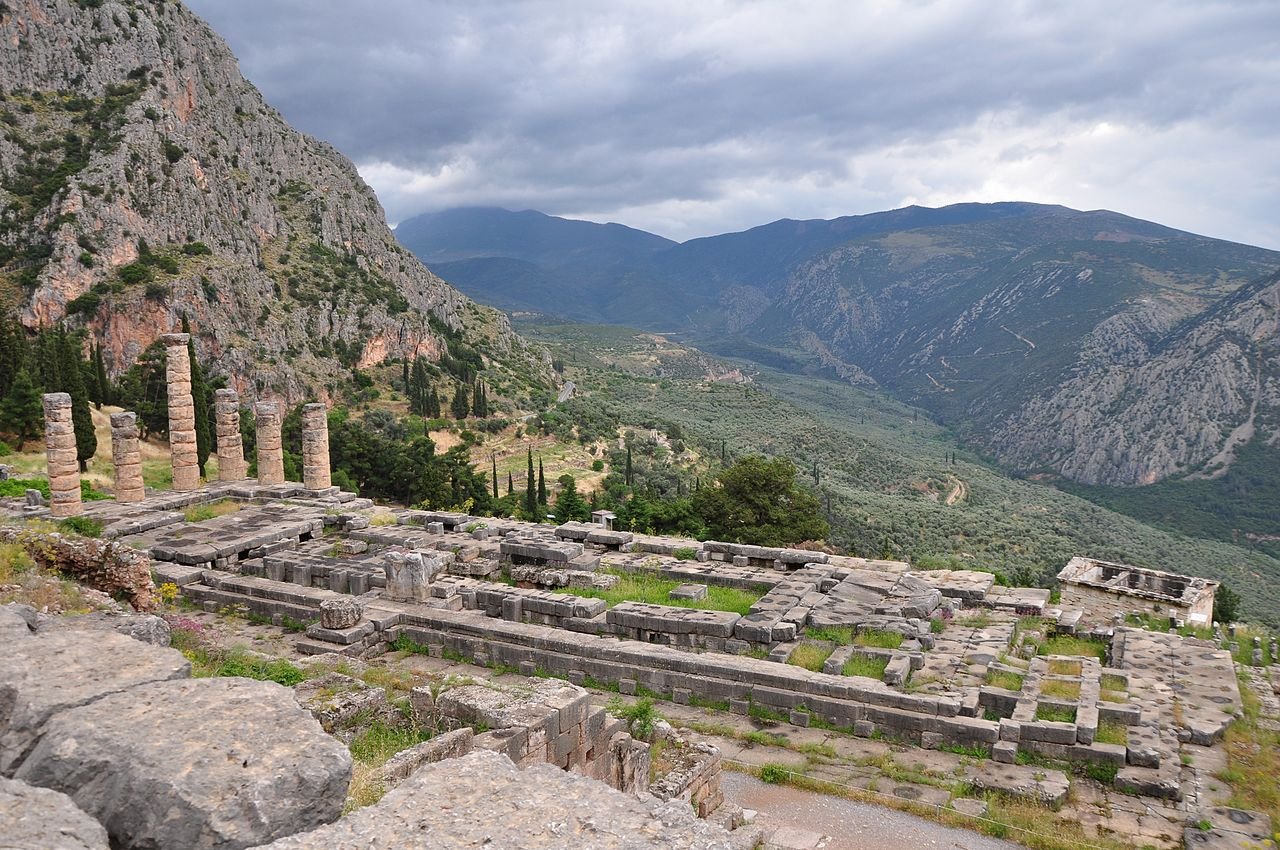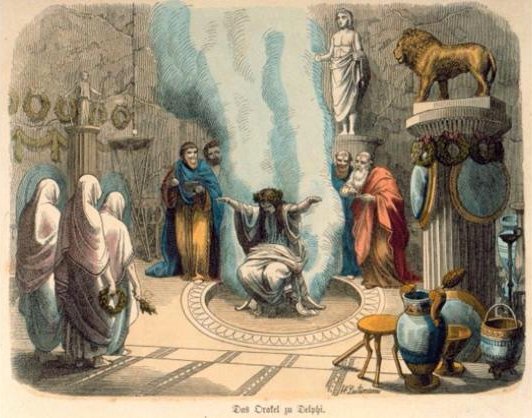Mystery Of The Delphi Oracle Prophecies: Was Pythia On Drugs While Guiding Ancient Greek Civilization For Thousands Of Years?
Ellen Lloyd - AncientPages.com - There are many beautiful ancient ruins we can admire in Greece, a country that is rich in history and culture. Among them are the so-called oracles, where priests and priestesses were believed to have received guidance from gods in the form of signs or messages that served as prophecies.
The temple of Apollo (the center of the Delphi oracle and Pythia) dated to the 4th century BC. Image credit: Helen Simonsson - CC BY-SA 3.0
When ancient Greeks and Romans had to make decisions, they consulted the gods. It could be done by drawing lots, casting dice, interpreting dreams, and analyzing such signs as sneezes, thunderbolts, and flying birds. However, when dealing with matters of the utmost importance, they sought to hear the words of the gods in the mouths of oracles.
As in many other ancient civilizations, priests and priestesses played an essential role in ancient Greece.
Great oracles and their priests became hugely important centers, visited by both individuals and city-states whenever there was a wish to acquire a divine connection.
One of the most famous oracles is that of Apollo at Delphi and Zeus at Dodona.
At the Oracle of Delphi, Pythia, the sanctuary's priestess, was seated in a state of trance, speaking on behalf of the gods delivering her prophecies and advising rulers, citizens, and philosophers on everything from their sex lives to affairs of state.
One aspect of the ancient Oracle at Delphi, which has fascinated scholars, scientists, and many ordinary people alike, is the nature and cause of the trance state attained by Pythia.
Numerous classical authors report that natural phenomena played an essential part in one of their most sacred religious rituals: the oracle at Delphi.
According to early ancient writers, people believed that it led into the underworld hundreds of years before the Temple at Delphi was first discovered by goat herders. Goat herders observed that their goats were acting crazy at this spot; when they were there, they had visions and premonitions.
Modern scientists were skeptical of the accounts and dismissed the ancient Greeks' explanation for the oracle's inspiration, vapors rising from the Temple's floor. Scholars rejected this explanation because archaeologists at the site of the Temple could not locate a chasm or detect gaseous emissions.
However, a group of scientists, archaeologists, and science historians discovered that the ancients were correct. In his book titled The Oracle, science historian William Broad and his scientist team prove the existence of the crossed fault lines and the presence of an intoxicating gas called ethylene in the rocks below the ancient Temple.
Like Walking the Bible, this fascinating book turns a modern eye on an enduring legend. The Oracle of Delphi was one of the most influential figures in ancient Greece.
A gripping modern-day detective story about the scientific quest to understand the Oracle of Delphi
Human mistress of the god Apollo, she had the power to enter into ecstatic communion with him and deliver his prophecies to men. Thousands of years later, Pulitzer Prize-winning journalist William J. Broad follows a crew of enterprising researchers as they sift through the evidence of history, geology, and archaeology to reveal—as far as science is able—the source of her visions. Read more
The team discovered that the oracle probably came under the influence of ethylene, a sweet-smelling gas once used as an anesthetic. In light doses, it produces feelings of aloof euphoria.
The presence of hydrocarbon gases can induce a narcotic state similar to that recorded from the trance state of Pythia.
So basically, it would mean Pythia was on drugs when she delivered the messages from the gods. Some researchers are not convinced that the intoxicating gas was rising below the ancient temple answers all questions.
The main objection against the ethylene theory is that it does not answer why only the priestess was affected by these toxic gases. Another point is that the quest to find what exactly put the priestess of Apollo at Delphi into a trance ignores the fact that her altered state may have been self-induced, perhaps to give the impression of objectivity when answering inquiries.
It has been repeatedly stated that Pythia rambled incoherent gibberish when in her trance, which had to be interpreted and reshaped into prophecies by the priests. However, American classical scholar Joseph Fontenrose (1903-1986), who spent many years researching the ancient mystery of Pythia, writes in his book The Delphic Oracle, Its Responses and Operations that Pythia's replies were no ramblings at all. According to Fontenrose, who examined several ancient texts, Pythia spoke with a clear voice and gave perfectly understandable replies. Fontenrose concluded there is a misconception about how the prophecies were delivered.
So, it seems we still have not entirely solved the ancient mystery of the Oracle at Delphi, and we do not know if Pythia was on drugs when she guided the ancient Greek civilizations for thousands of years. Further scientific studies of the ancient site might bring us closer to the truth.
Written by Ellen Lloyd – AncientPages.com
Updated on September 13, 2022
Copyright © AncientPages.com This material may not be published, broadcast, rewritten or redistributed in whole or part without the express written permission of AncientPages.com
More From Ancient Pages
-
 4,700 ‘Forest Islands’ Created By Amazon’s Earliest Humans
Archaeology | Apr 15, 2020
4,700 ‘Forest Islands’ Created By Amazon’s Earliest Humans
Archaeology | Apr 15, 2020 -
 Magnificent Hochdorf Chieftain’s Grave – Resting Place Of The Celtic Tutankhamun
Featured Stories | Aug 19, 2019
Magnificent Hochdorf Chieftain’s Grave – Resting Place Of The Celtic Tutankhamun
Featured Stories | Aug 19, 2019 -
 Ancient Egyptian Visual Depiction Of The Milky Way Discovered
Archaeoastronomy | May 2, 2025
Ancient Egyptian Visual Depiction Of The Milky Way Discovered
Archaeoastronomy | May 2, 2025 -
 Teotihuacan’s Puzzling Red Glyphs Could Be Unknown Ancient Writing
Archaeology | Sep 22, 2020
Teotihuacan’s Puzzling Red Glyphs Could Be Unknown Ancient Writing
Archaeology | Sep 22, 2020 -
 Wonderful Long-Lived Nymphs In Greek And Roman Mythologies
Featured Stories | Mar 29, 2024
Wonderful Long-Lived Nymphs In Greek And Roman Mythologies
Featured Stories | Mar 29, 2024 -
 Tartarus – The Land Of The Dead – Mysterious Underground World
Featured Stories | Sep 13, 2015
Tartarus – The Land Of The Dead – Mysterious Underground World
Featured Stories | Sep 13, 2015 -
 Troublesome Ancient History Of Forks That Were Long A Shocking Sensation
Featured Stories | Nov 20, 2023
Troublesome Ancient History Of Forks That Were Long A Shocking Sensation
Featured Stories | Nov 20, 2023 -
 Shell Trumpets In Neolithic Catalonia Were Used For Effective Long-Distance Communication
Archaeology | Dec 9, 2025
Shell Trumpets In Neolithic Catalonia Were Used For Effective Long-Distance Communication
Archaeology | Dec 9, 2025 -
 Pre-Columbian Americans Mastered Electricity – Ancient Inscription And Document Reveal Proof Of Advanced Ancient Technology
Ancient Mysteries | Feb 4, 2018
Pre-Columbian Americans Mastered Electricity – Ancient Inscription And Document Reveal Proof Of Advanced Ancient Technology
Ancient Mysteries | Feb 4, 2018 -
 Strange Ancient Structures In The Northeastern U.S. Were Built By Unknown People With Shining Shields, Native Americans Say – Evidence Of Norsemen Or Celts?
Featured Stories | Apr 8, 2025
Strange Ancient Structures In The Northeastern U.S. Were Built By Unknown People With Shining Shields, Native Americans Say – Evidence Of Norsemen Or Celts?
Featured Stories | Apr 8, 2025 -
 Jelling Stone And Legendary Harald ‘Bluetooth’ King Of Denmark – ‘Who Made The Danes Christian’
Vikings | Oct 10, 2015
Jelling Stone And Legendary Harald ‘Bluetooth’ King Of Denmark – ‘Who Made The Danes Christian’
Vikings | Oct 10, 2015 -
 Old Cannon Found At Construction Site
Archaeology | Apr 22, 2020
Old Cannon Found At Construction Site
Archaeology | Apr 22, 2020 -
 ‘Bone Biographies’ Reveal Lives Of Medieval England’s Common People And Illuminate Early Benefits System
Archaeology | Dec 6, 2023
‘Bone Biographies’ Reveal Lives Of Medieval England’s Common People And Illuminate Early Benefits System
Archaeology | Dec 6, 2023 -
 Secrets Of Ark of The Covenant Revealed In Ancient Manuscript
Biblical Mysteries | Jul 19, 2014
Secrets Of Ark of The Covenant Revealed In Ancient Manuscript
Biblical Mysteries | Jul 19, 2014 -
 Ancient Figure Carved From Volcanic Tuff Unearthed In Argishtikhinili, The Fortified City Of The Kingdom Of Urartu
Archaeology | Oct 22, 2025
Ancient Figure Carved From Volcanic Tuff Unearthed In Argishtikhinili, The Fortified City Of The Kingdom Of Urartu
Archaeology | Oct 22, 2025 -
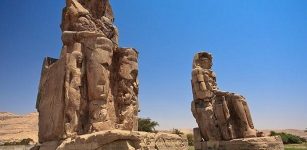 Colossi Of Memnon: Gigantic Stone Statues Guarding The Temple Of Pharaoh Amenhotep III
Civilizations | Jul 13, 2016
Colossi Of Memnon: Gigantic Stone Statues Guarding The Temple Of Pharaoh Amenhotep III
Civilizations | Jul 13, 2016 -
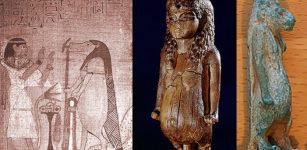 Taweret – Powerful Egyptian Hippopotamus ‘Household Goddess’ Guarded Childbirth, House, Sleep And Dispelled Evil Forces
Egyptian Mythology | Jul 16, 2018
Taweret – Powerful Egyptian Hippopotamus ‘Household Goddess’ Guarded Childbirth, House, Sleep And Dispelled Evil Forces
Egyptian Mythology | Jul 16, 2018 -
 Your Neanderthal Genes May Prevent You From Metabolizing Drugs Efficiently
Archaeology | Jul 25, 2022
Your Neanderthal Genes May Prevent You From Metabolizing Drugs Efficiently
Archaeology | Jul 25, 2022 -
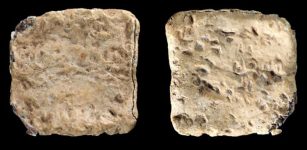 Rare ‘Cursed’ Tablet Predating The Dead Sea Scrolls Discovered On Mount Ebal Could Re-Write History – Scientists Say
Archaeology | Mar 25, 2022
Rare ‘Cursed’ Tablet Predating The Dead Sea Scrolls Discovered On Mount Ebal Could Re-Write History – Scientists Say
Archaeology | Mar 25, 2022 -
 Ziggurats, Axis Mundi And Strong Connection To Religion In Mesopotamia
Featured Stories | Mar 17, 2021
Ziggurats, Axis Mundi And Strong Connection To Religion In Mesopotamia
Featured Stories | Mar 17, 2021

